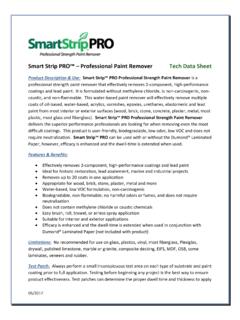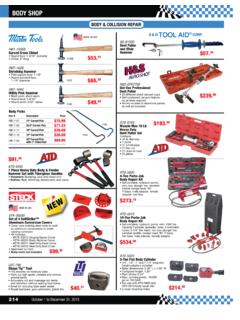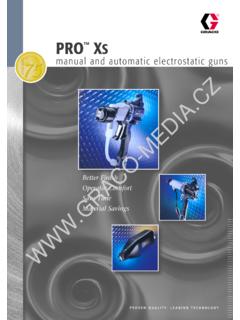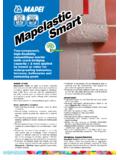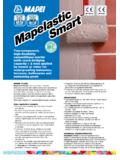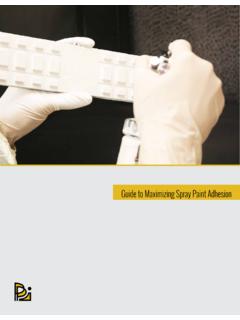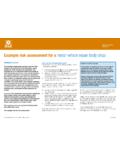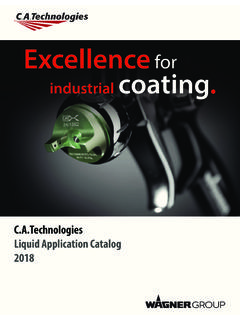Transcription of RESEARCH REPORT 311 - Health and Safety Executive
1 HSEH ealth & SafetyExecutiveAn occupational hygiene assessment of the useand control of isocyanates in the UKPrepared by Institute of Occupational Medicine for the Health and Safety Executive 2005 RESEARCH REPORT 311 HSEH ealth & SafetyExecutiveAn occupational hygiene assessment of theuse and control of isocyanates in the UKHilary A Cowie, Graeme W Hughson, Karen S Creely,Mairi K Graham, Peter A Hutchison, Robert J AitkenInstitute of Occupational MedicineResearch Park NorthRiccartonEdinburghEH14 4 APThere is growing awareness of an increasing number of occupational asthma cases, which areassociated in some way with exposure to isocyanates, particularly for spray painters in the motorvehicle repair (MVR) industry. Isocyanates are also in widespread use in polyurethane manufacturing processes and the companiesinvolved in this work are diverse and dynamic, making it difficult to identify the population study identified the different industry sectors where isocyanates were used and providedestimates of the total number of workers potentially exposed.
2 In addition, further information aboutworkplace exposure levels, working practices and exposure control measures were obtained by visitinga limited number of non-MVR companies. Separate investigations were being made in the MVR is estimated that approximately 6200 MVR companies use isocyanates, with around 15000employees directly exposed. In the non-MVR sector, a total of 1657 companies were estimated to useisocyanates, with around 7000 employees directly the main, companies carrying out work with the greatest potential for exposure were aware of thehealth risks and had taken appropriate action to control workers exposures. The results of theworkplace surveys confirmed that exposure levels were generally low and that it was possible tocontrol air concentrations to below the existing exposure limits with basic exposure control results suggest that isocyanate related asthma cases could be due to momentary lapses inexposure controls rather than prolonged, high level exposure that might be attributed to ignorance ofthe Health risks and the recommended control measures.
3 Alternatively, it is possible that the existingexposure limits for isocyanates are not set an appropriate level for adequate protection of REPORT and the work it describes were funded by the Health and Safety Executive (HSE). Itscontents, including any opinions and/or conclusions expressed, are those of the authors alone and donot necessarily reflect HSE BOOKSii Crown copyright 2005 First published 2005 ISBN 0 7176 2959 7 All rights reserved. No part of this publication may bereproduced, stored in a retrieval system, or transmitted inany form or by any means (electronic, mechanical,photocopying, recording or otherwise) without the priorwritten permission of the copyright for reproduction should be made in writing to: Licensing Division, Her Majesty's Stationery Office, St Clements House, 2-16 Colegate, Norwich NR3 1BQ or by e-mail to - iii - CONTENTS Section Description Page Executive SUMMARY v 1.
4 INTRODUCTION 1 Background to the study 1 Overview of isocyanate use 1 Summary of isocyanate related Health effects 2 Structure of this REPORT 3 PART 1 Telephone and postal questionnaire survey 5 2. AIMS AND OBJECTIVES 7 3. METHODS 9 Overview of study design 9 Questionnaire design 9 Telephone questionnaire 9 Postal questionnaire 10 Survey and questionnaire piloting and review 10 Survey of MVR Sector 11 Identification of companies 11 Sample processing 13 Survey administration 14 Survey of other sectors 14 Identification of companies and sample selection 14 Survey administration 16 Data processing 17 Statistical analysis 17 4.
5 RESULTS : MVR SECTOR 19 Telephone survey participation and response 19 Telephone survey results 19 Frequency of use of isocyanates 20 Jobs and tasks in which isocyanates are used 22 Use of ventilation and respiratory protective equipment 22 Extrapolation to the general population 24 Results from postal questionnaire 25 Postal survey response 25 Isocyanate products used 26 Pattern and nature of work 27 Equipment, training and cleaning 27 Ventilation 28 Respirators and personal protective equipment 28 Spills or leaks 29 Air monitoring and Health surveillance 30 Comparison of telephone and postal survey responses 30 General comparison between survey results 30 Comparison between companies that participated in both surveys 30 5. RESULTS : NON-MVR SECTORS 33 Telephone survey participation and response 33 Telephone survey results 33 Details of participating companies 33 Use of isocyanates 34 Reclassification of company sector 36 Summary of results for the non-MVR sector 37 Use of isocyanates 37 Job details 42 Use of RPE and ventilation 42 Extrapolation to the general population 46 6.
6 SUMMARY OF PHASE 1 RESULTS 47 MVR sector 47 Non-MVR sectors 47 PART 2 Occupational Hygiene Monitoring Survey 49 7. INTRODUCTION TO PHASE 2 51 8. AIMS AND OBJECTIVES 53 9. LEGISLATION AND GUIDANCE 55 10. METHODS 57 Selection of companies for study sample 57 Categories of use 57 Company selection 58 Survey methodology 60 Sampling and analytical methods 60 Collection of contextual information 60 Evaluation of control measures 61 Biological monitoring 61 Data analysis 61 Reporting 61 11.
7 RESULTS OF WORKPLACE SURVEYS 63 12. DISCUSSION OF PHASE 2 RESULTS 67 13. OVERALL CONCLUSIONS 71 14. RECOMMENDATIONS 73 15. ACKNOWLEDGEMENTS 75 16. REFERENCES 77 APPENDICES 81 A1 Sample size calculations 83 A2 Telephone questionnaire for MVR sector interviewer script 85 A3 Telephone questionnaire for MVR sector recording sheet 93 A4 Postal questionnaire MVR sector 99 A5 Telephone questionnaire non-MVR sectors 113 A6 Postal questionnaire non-MVR sector 127 A7 Postal questionnaire SMART repairers 141 A8 Detailed results for the non-MVR sector 155 A9 Detailed observations from site surveys 205 iv Executive SUMMARY Introduction There is growing awareness of an increasing number of occupational asthma cases, which are associated in some way with exposure to isocyanates, particularly in occupations where paints and other coatings are applied by spray methods.
8 Isocyanate based paints are particularly useful in the motor vehicle repair (MVR) industry and it is from this particular sector that the greatest number of asthma cases have been observed. Isocyanates are also in widespread use in polyurethane manufacturing processes. Polyurethane is used as an insulation material in many applications and is also used to produce flexible and rigid foams, moulded plastic components, various adhesives and sealants. Due to the highly diverse and growing use of polyurethane, combined with the dynamic nature of the companies involved, this industry sector is much more difficult to categorise. Therefore, relatively little is known about the numbers of workers and methods of work in the companies using these chemicals. In Phase 1 of this study, by means of telephone and postal questionnaires, we were able to identify the different industry sectors where isocyanates were used and have provided estimates of the total number of workers potentially exposed.
9 In addition, in Phase 2, further information about workplace exposure levels, working practices and exposure control measures were obtained by carrying out occupational hygiene surveys in a limited number of non-MVR companies. Work to investigate conditions in the MVR industry sector was being carried out separately. The aims and methods, results and conclusions for each phase of this study are briefly described in the following paragraphs and some recommendations are provided at the end of this summary. Phase 1 study Aims and Methods The main aim of the Phase 1 study was to obtain quantitative, representative information from the motor vehicle repair (MVR) industry and from different industries within the non-MVR sector where isocyanates are used. The information collected included the size of the exposed population, the job profiles of those exposed, working practices and measures used to control occupational exposure to isocyanates.
10 Workplaces in the MVR sector were identified using the Business Yellow Pages, selected because it is comprehensive, up to date, contains full contact details and details of numbers of employees. It is a free medium for advertising and so it is likely to be complete. Workplaces from the non-MVR sectors included a wide variety of industries, including isocyanate producers, flexible foam manufacturers, rigid foam manufacturers, vehicle manufacturers, foundries, small to medium repair technique (SMART) repairers, coatings and adhesive manufacturers, insulation contractors, construction firms, industrial painters and printers and laminators. These were identified from a number of different sources including trade associations, listings on the Internet and business directories including the Yellow Pages website and the Kelly Search website ( ). The target study sample comprised 1500 companies from the MVR sector and a total of 500 companies from other sectors.










